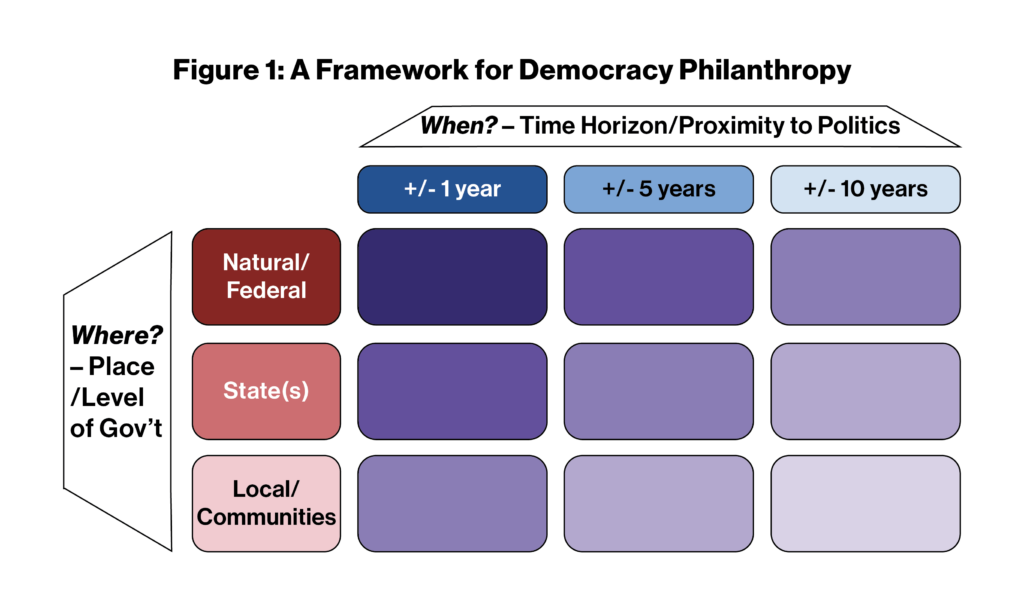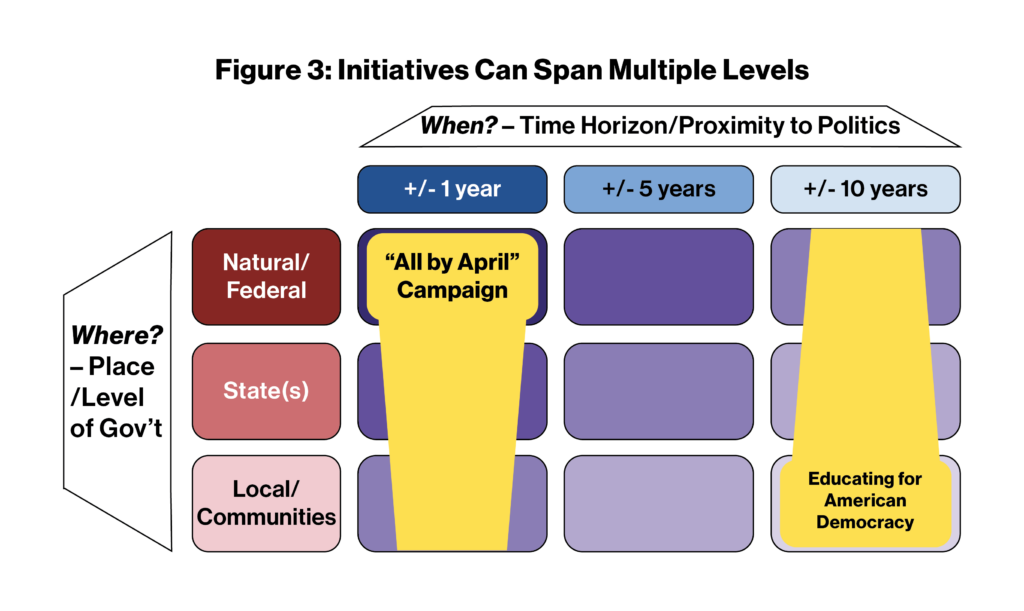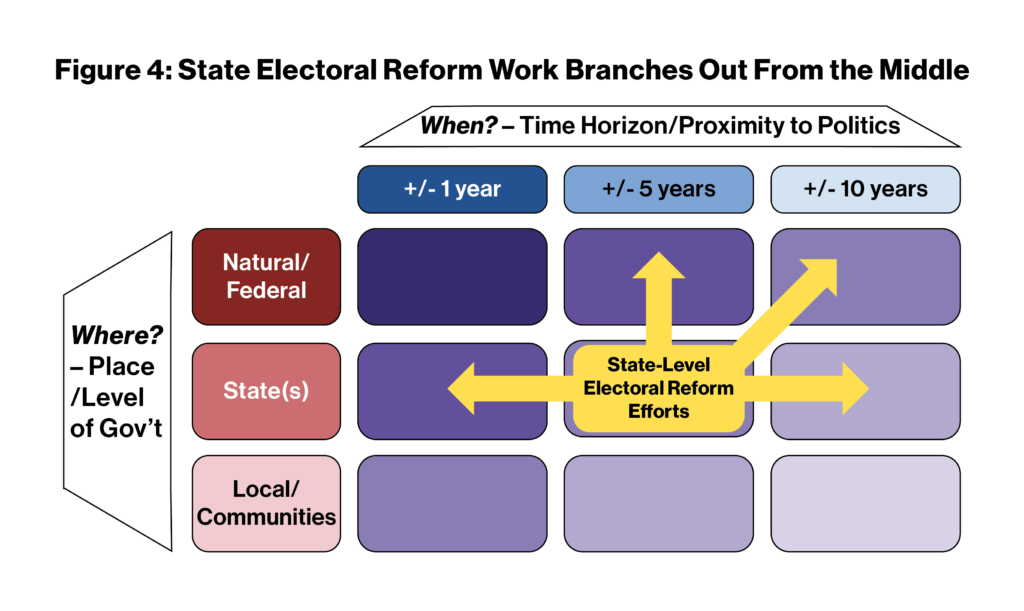This post originally appeared on The Art of Association blog.
It is challenging for philanthropic funders to get started and stay focused when it comes to strengthening democracy. The vagaries of our political system — really a complex system of systems cast on a continental scale — make it hard to know where even to begin. There are dozens of solutions that could be worthy of support. Alas, none are backed by dispositive evidence indicating that they are the single-best way forward. Then, every second and fourth year, elections reset the stage of democracy and reshuffle the cast of characters, often in unsettling ways.
Democracy’s proximity to politics further complicates the philanthropic picture. The tax code bars foundations from backing or opposing candidates, parties, and ballot measures. Many foundations take a belt and suspenders approach to this proscription on electioneering by avoiding anything that smacks of politics (as democracy-related causes frequently do). Other foundations, in contrast, push right up to the edge, seeking to exploit all the legal ways they can underwrite voter registration, education, and participation, ostensibly on a nonpartisan basis, to further their political goals.
Unlike foundations, individual philanthropists retain the ability to make political campaign contributions (on a non-tax deductible basis). These funders thus face a trade off. They must decide why, when, and where they should make philanthropic versus political donations. Given the bewildering choices on the charitable side, and the clarity of a candidate asking them for money, they often conclude the best or at least most straightforward way they can support democracy is by donating to their preferred politicians.
I have been workshopping a framework to help philanthropists — both foundation and individual donors — make sense of the democracy field. It is proving especially helpful for funders exploring whether and how they might seek to strengthen democracy, rife as the field is with complexities and disruptions. They are wary of putting their money behind what they worry — often rightly — are the political agendas and/or insufficient solutions of funders and advocates already knee-deep in the fray.
Two Clarifying Questions
Instead of asking philanthropists to start with the problems they want to solve, or the specific solution(s) they want to advance — things they are trying to figure out — this framework has them consider more basic but nonetheless clarifying questions. Where and when might they want to make a difference?
The question of where funders seek to make a difference can be answered in one of three ways: at the federal/national level, in one or more states, or in local communities. It is often a reassuring revelation for inquiring funders that strengthening democracy does not necessarily mean wading into the Thunderdome of our national politics. They can find many more tractable opportunities in the states and communities where they live, have local knowledge and networks, and whose civic health they care about in particular. They can also support work across multiple “laboratories of democracy” at the state and local level to help test, pilot, and scale up promising initiatives.
The question of when funders seek impact can also be answered in one of three ways – in this instance, different time scales. The first is the next year or two. Near-term efforts to make change happen within the political confines of an election cycle or its aftermath fall into this category. The second time scale is wider, five years or so. In this medium-term interval, focused efforts to reform elections, strengthen governing institutions, or bring about other systems changes can develop and come to fruition. The third time horizon stretches out to a decade and longer. It takes such durations to form and educate citizens, develop future leaders, rebuild social trust, revitalize civic culture, or amend the Constitution.
Note these time scales closely correspond with proximity to politics. Efforts to impact democracy in the next 1-2 years tend to be much more politically salient than those that will unfold over a decade or more.
Fleshing Out the Framework
The two dimensions of this framework produce the 3×3 matrix – or map, if you will – depicted in Figure 1 below. It enables funders exploring the democracy field to situate and understand various efforts they might pursue in the contexts of their geographic footprints and time horizons.

Go East and South, Democracy Philanthropist!
I should explain the shadings of the different regions of the map. The tribal dynamics of the Trump Era have made the northwest corner the most crowded and hotly contested space on the map. Funders across the ideological spectrum are increasingly attempting to drive near-term, national-level changes.
The darker shades of purple in this corner are meant to convey its crowded and hotly contested nature. The pressure and conflict is amplified by the adjacent billions in political spending being deployed just outside the upper left region of our map, a massive pile that dwarfs what philanthropy can bring to bear.
Philanthropic funders will find less competition and more room to maneuver if they can resist the gravitational pull of trying to shape national politics in the near term. Instead, they should head toward the lighter, lavender-shaded regions in the southeast corner. Philanthropic funding is comparatively advantaged when it supports longer run changes in the decentralized laboratories of U.S. democracy.
To illustrate this point, consider Figure 2 below. The philanthropy underwriting Project 2025’s plans to rein in the federal administrative state clearly places it in the northwest corner. I expect most of you will have heard of this project and the controversy and opposition it has generated. Even former President Trump has been at pains to distance himself from this effort led by his most determined partisans.
In contrast, funding for the Trust for Civic Life, a promising initiative to revitalize democracy through longer-term, bottom-up work in local communities, registers in the opposite, southeast corner of the map. You may not have heard of the Trust yet. Pundits do not line up for cable news hits denouncing it as a danger to the republic, and neither presidential candidate has felt obliged to come out against it.

Not all charitable sector efforts to bolster democracy fall so neatly in one part of the map. They often span multiple levels. That said, in these permutations, the work typically needs to take hold at one level in particular to realize the overall goal.
Let’s consider two such efforts in Figure 3 below. The first is the All by April campaign spearheaded by progressive philanthropy. It seeks to deploy funding in a timely way this year to ensure it makes a difference at the national, state, and local levels in the run up to the November election. It is a safe assumption, however, that the states and localities most critical in determining national political outcomes will receive a disproportionate amount of the campaign’s funding.
Alternatively, consider the funding that supports the rollout of the Educating for American Democracy initiative. This is a longer term effort to establish a national framework for civic education that states and school districts can readily and flexibly adapt and implement. In this case, the work ultimately needs to get traction locally, in schools across the country, to pay the dividends it seeks to provide.

Other civil society efforts operate at multiple time scales and levels simultaneously. The past decade has seen a sustained but unsuccessful effort at the federal level to move a comprehensive electoral reform bill. More recently, electoral reform advocates like the Center for Ballot Freedom, FairVote, the Institute for Political Innovation, and Unite America, along with the funders supporting their 501(c)3 work, have focused more productively on advancing discrete reform proposals at the state level. These include, e.g., final five and top two election systems, fusion voting, open primaries, and ranked choice voting.
As indicated in Figure 4 below, the optimal time frame for philanthropy to operate here is 3-5 years out, providing the nonpartisan research, analysis, and education to lay the groundwork for these efforts. Closer-in pushes to get them enacted ultimately need political funding, as is the case with ballot measures to be decided in Nevada, Idaho, and Arizona this November.
Funders and advocates of these efforts are convinced that, as more of these state-level reforms pass, they will have depolarizing ripple effects at the national level in the medium and longer term. And to ensure they are gaining a sufficiently expansive geographic footprint, these funders and advocates are also seeding longer term efforts in states where such reforms are not currently being considered.

There you have it — the overall framework and some examples to bring it to life. In the spirit of continuous improvement, please let me know what resonates, what does not, and what questions it raises for you.


